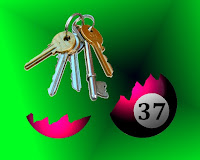The end of the year wouldn't be the same without the confettis, such spirals that become helices when we launch them to the air. There are thousands of examples of mathematical curves all around us that we hardly notice: Archimedes spirals, logarithmic spirals, spirals of Fermat... if we talk about two dimensions. And cylindrical, conical, spherical helices... if we think in three dimensions. Before midnight, several of these curves will get in the path of Joe Vitruvius.
FIRST HALF

The teams of AS Monaco and Las Vegas Mobsters are going to play a charity match on New Year's Eve, for helping the victims of
Monte Carlo method.
Players jump into the pitch to start the training session before the match, when the delegate of the club realizes that there are no balls.
The club's kit man has gone off on holidays, so the delegate is about to pick up the keys of the material store from his office, but instead of keys, he finds a Christmas album hanging on the hanger. He tries to telephone him, but there is no way to contact the kit man.
He's a person who likes mind traps, so the disk may represent not only his New Year's greeting to his peers, but also some kind of clue to find the keys.

Joe Vitruvius has come to the stadium to watch the game, so the chairman invites him to go down with him to the locker room to see if they can solve the problem.
- Wow, an album of U2! New Year's Day! What a beautiful song to celebrate the New Year!
- Yes, but it would be even more beautiful if it was a key. We can't open the door of the room where we store the balls, with this disk.
- And what do you want me to do? It would be better to call a locksmith.
- Yes, but today is New Year's Eve, and there is no open shop. We will not find any locksmith who wants to come to unlock the door before the time of the start of the match is over.
- I know nothing about how to open locked doors...
- But you know a lot about mind puzzles. And we are convinced that the disk is one of them. In addition, the kit man loves Maths, so we're sure that the album must represent a mathematical clue.
SECOND HALF

- Have you tried to play the disk just to see if it includes any
recorded message indicating the place where he has left keys?
- Luckily we still have an old record player in the office. We played the album, and the only we heard is the song. It's very strange that he used a vinyl record, instead of something more modern such as a CD or a digital format.
- Maybe this is the clue.
- Oh, yes?
- Yes, it's possible. Do you know how a vinyl record is recorded?
- Not entirely.

- Unlike compact disks, the information in vinyl disks is recorded in
a single track. It's a spiral track, that a needle reads moving from the edge of disk to its center.
- So it's only one single groove, right?
- In fact, this type of curve has a special name in Mathematics. It's called Archimedean spiral, as this ancient wise Greek man described it in his treatises.
- Were there music albums in those days?
- No. Archimedes used this spiral for his studies of squaring the circle.
- And has it got any other uses?
- Of course. It has multiple applications. It's used in the mechanisms of air conditioning, in certain tests for the diagnosis of neurological diseases, to calculate the concentrations of bacteria, or for really important issues such as counting the meters of toilet paper on a roll, for example.
- I see. I imagine that the formulas used for its description will be very complex, right?
- It depends. If we define it with polar coordinates (r,θ), the expression we have is very simple:
r = a + b·θ
- It's true, it seems simple, but I don't understand anything.

- The formula says that the distance (r) of each point of the curve from the origin, depends on the turns (θ) and on a coefficient (b). The larger this coefficient is, the greater the distance between the turns of the spiral.
- Well, it was not that complicated. But I think we are giving around the bush like in an Archimedean spiral, without actually any conclusion.
- Well, I think we should search for somewhere in the stadium where we can find another spiral of Archimedes.
- Hmmm. I don't know.
- I think that, at the entrance, I saw a magnificent Christmas tree. I've noticed the lights arrangement, and I saw that they formed a perfect spiral of Archimedes.
- Oh, yes?
- Well, not exactly. It would be rather a
conical helix, as it is a continuous curve which develops in three dimensions. But if we look at the tree
from above, and project the helix in only two dimensions, we would see that the lights are arranged according to an Archimedean spiral.
- Who put up this tree?
- The kit man.
- Well, we're approaching the solution.
- But where can he have hidden the keys? Hanging from a branch?
- I don`t think so. They may be within any of the balls that adorn the tree. If you look, at them, all have a number.
- Yes, but which ball will we choose? We have no time to break all the balls to see if we find the keys within any of them.

- He hasn't left us more clues, except the disk with the Archimedean spiral. So we should focus in it. This spiral is also known by another name:
Archimedean roulette...
- Ah! Now that you mention it, I remember that before he worked for our club, he was employed as a croupier at the Grand Casino. Perhaps there is some sort of relationship with the roulette you say.
- Certainly. The roulette is a game invented by the Mathematician Blaise Pascal, who established its rules on the 17th century. This rules haven't experienced any outstanding change since then. The most important new was introduced to include, among the 36 existing numbers, the red and black ones, an extra green number, zero, exclusive for the casino, which allows it to get some profits.
- Given that he worked as a croupier at the casino, perhaps we should then open the ball number 37.
- What an ugly number!
- There are no ugly numbers. For example, 37 is a fascinating number, because it's a prime number that is factor of all three-digit repdigit numbers.
- Repdigit numbers?
- Yes, numbers that are composed by repetition of the same figure: 111, 222, 333...

- Ah! It's okay. Let's try with ball number 37.
- Correct: here are the keys! Go quickly to open the door and get the balls so that the match can be played.
- And we're going to the VIP box to open a few bottles to celebrate the resolution of the problem, and to wish all our followers a Happy New Year!

And don't forget to take a walk by the 130th Carnival of Mathematics. There you'll find lots of excellent math posts that you'll surely like too.


















